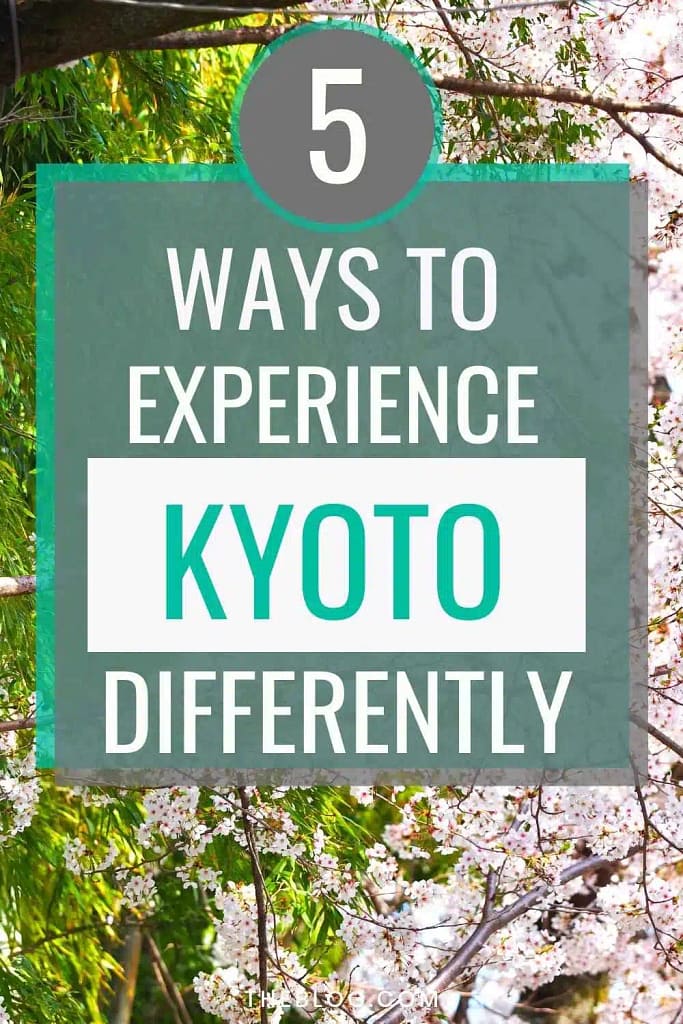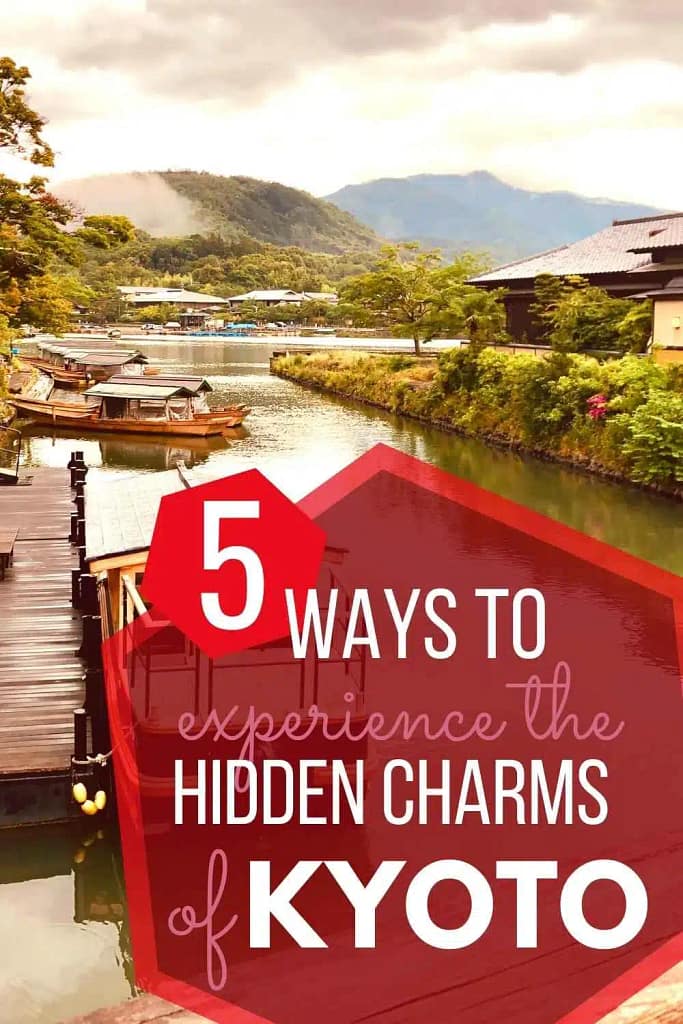5 WAYS TO EXPERIENCE THE HIDDEN CHARMS OF KYOTO
Kyoto is a proud imperial city. Experiencing Kyoto is like taking a stroll through eleven centuries worth of ancient Japanese history concentrated at one location. So rich is Kyoto’s history and heritage; that even to this day, it houses over 20 percent of Japan’s national treasures.
Yet, Kyoto comes off as quite elusive to the inexperienced, unguided traveller. Just like any other place in Japan maybe. Underrated definitely, but not overpoweringly ‘wow’.
But that’s just something from the sloppy visitor, which of course, you are not. Kyoto’s beauty can need a little ‘finding’. But it is like magic unfolding before your eyes once you transition to becoming a thoughtful traveller who knows what Kyoto is all about.
Kyoto was once the home of Japan’s imperial court and although that’s something that makes up all Kyoto guide books, it is certainly not all that Kyoto was known for. The city was once the centre of traditional Japanese arts, crafts and religion. And the city’s aesthetics even today point to this history of music, dance and theatre, if only you know where to look.

Picture Courtesy:YOTRIPP via Canva Pro
So if you’re on a vacation in Japan, here are 5 ways to experience the hidden charms of Kyoto.
01.
Temples & Shrines
Because the city was spared of Allied bombings during World War II, most of its monuments, temples and shrines still stand today. And that is quite something! Because there are more than 300 Shinto shrines and over 1700 Buddhist temples just in Kyoto. Many are hidden amid the modernity of its cityscapes. But spend some time here, go hunting and you’ll know that each one is possibly more beautiful than the last.
Kyoto’s temples are a little different from the temples you may have seen around the world. Through them, you get a glimpse of the Japan of the past, almost as soon as you enter one. Each temple here is not one structure but a series of buildings within a closed compound that inevitably houses a garden too. These elusive temples are worth hunting for, especially true if you want Kyoto to show you its own unique beauty, unseen by so many others.
02.
Path of Philosophy
The Path of Philosophy or Philosopher’s Path is a mile-long sakura-lined pathway just begging for visitor footfall. Not only are its experiences and sights totally worth the hike, but the path is dotted with Kyoto’s top attractions along the way.
Important cultural sites such as the Gingkakuji Temple (Temple of the Silver Pavilion), the Ryoanji Temple and multiple other temples and shrines can be visited via slight deviations along the marked path. What’s more, there even a Manga museum for Manga lovers!
The Gingkakuji Temple is a must-visit purely for the pleasure of strolling through the surrounding ‘minimalist’ gardens, which were designed for meditative strolling by Kyoto’s famous landscape architect Sōami.
Want to know more about the Path of Philosophy? Find out more about the attractions along the path, their timings, their fees and all other relevant information in this ‘Path of Philosophy‘ article.
03.
Backstreet Crafts
Kyoto has a rich history of arts and crafts. So much so, that long back, when the city was building itself, entire neighbourhoods were built upon around specific crafts where the country’s finest craftsmen for that trade could be found. Today, these neighbourhoods have dispersed, but their legacy still remains.
Though you may have to go on something quite like a treasure hunt, you can still find hidden gems if you know where to look. These hidden gems, namely workshops, are still found in the quiet, unglamorous backstreets of these historic neighbourhoods. Go hunting for anything and everything ranging from textile and silk goods, Japanese dolls, paper goods, woodblock prints, lacquerware and more.
It is quite an adventure meeting and talking to the descendants of craftsmen who have chosen to stay true to their family’s traditional crafts. Their work is the modern-day testimony to their legendary fame for artistry even today. They still maintain the refinement, tradition and elegance of the old.
04.
Annual Matsuri
One of the best times to visit Kyoto is during their annual festivals, locally known as matsuri. Out of the many festivals of Kyoto, three are worth checking out. The Jidai, the Aoi and the Gion. Don’t miss these three Kyoto festivals if you are in Japan, even if it means juggling around your planned Kyoto itinerary just to fit them in.
Planning your itinerary for Kyoto to include experiencing these festivals is highly recommended since booking hotels for these times is expensive and is best done well in advance.
The Jidai festival is only about a century old. It is celebrated by thousands of Kyotoites who descend on the city in hordes to participate in it on October 22nd each year. The festival is a delight to visitors who have never experienced anything quite like it before. On the day of the festival, a theatrical procession snakes through the streets of Kyoto. Exotic local costumes from as far back as the 8th century (and as recent as the 19th century) are put on brilliant display here. If you love photography or you are an Instagrammer looking to build a travel-related audience, be sure to attend this festival. It can give you epic pics!
The Aoi Festival is a spring festival that makes its way to town on the 15th of May. And though it is still spring and the surrounds are still lovely and fresh, Kyoto’s cherry blossoms are unfortunately long gone by this time. During Aoi, the fun is truly on the streets. Hundreds of festival participants dress up in imperial courtier costumes and make their way to Shimogamo Shrine to pray for the city’s growth and prosperity. The Aoi is said to be one of the oldest surviving festivals in the world. It is believed to have started in the 6th century.
And then in July, on the 16th and 17th of July to be exact, Kyoto celebrates the Gion festival. Some thirty plus floats proceed through the streets of Kyoto to the entertainment of onlookers. The objective of the festival is also to pray for Kyoto’s wellbeing and prosperity. The festival was birthed during the 9th century when the city was gripped by a massive plague.
05.
Cherry Blossoms or Sakura
Unfortunately, none of Kyoto’s best festivals coincides with its cherry blossoms. The best times to see Kyoto’s cherry blossoms in their full glory is actually April. And one of the best places to see and experience Kyoto’s cherry blossoms is the Philosopher’s Path or Path of Philosophy that we talked about earlier.
Cherry blossoms or sakura usually bloom in the last week of March and are best viewed between the 20th of March and the 14th of April. The first week of April is your best bet to catch the best of these blooms. If you wonder where you could admire these cherry blossoms? Below are our answers to the popular ‘where to see cherry blossoms in Kyoto’ question.
Cherry blossoms are best seen (apart from the Philosopher’s Path, which is the top recommendation) at Arashiyama, Keage Incline, Kodai-Ji Temple, Ninenzaka Street, Sannenzaka Street, Maruyama Park and Shirakawa Canal. That said, these are the more popular places for hanami (sakura viewing) and consequently are often crowded. If you prefer good sakura views minus the crowds, go for Takenaka Inari Shrine, Takase River, Yoshida-jinja Shrine, Shinyodo Temple, or Kokai-Komyoji Temple instead.
If you find yourself in Kyoto during spring, do not miss the Geisha spring dances (Geiko) and Temple Night illuminations.
Some Common Questions About Visiting Kyoto:
How to get to Kyoto from Tokyo?
The easiest way to get to Kyoto is to take the bullet train from Tokyo. It is a 3-hour journey. If you are looking to hit multiple locations across Japan, getting a Japan Rail Pass for the required duration works out easier and cheaper.
Where to shop in Kyoto?
Apart from the backstreet shops by heritage craftsmen (mentioned earlier), there are several places to shop in Kyoto. Kyoto is a well-known shopping district. The largest concentration of Japanese speciality stores is in the Gion district. But if you’re pressed for time, the Kyoto Handicraft Center offers the perfect one-stop-shop solution. (Heian Jingu Kita, Sakyo-Ku)
What are the best times to visit Kyoto?
If you wish to see cherry blossoms, the best time to visit Kyoto is in early April. If you want to experience Kyoto’s numerous festivals, you have to time your journey to the festival dates.
When is the Jidai Festival in Kyoto?
October 22 , each year.
When is the Aoi Festival in Kyoto?
May 15, each year.
When is the Gion Festival in Kyoto?
July 16 & 17, each year.
If you have enjoyed reading this Kyoto’s hidden gems article, please share it with your tribe on social media.







